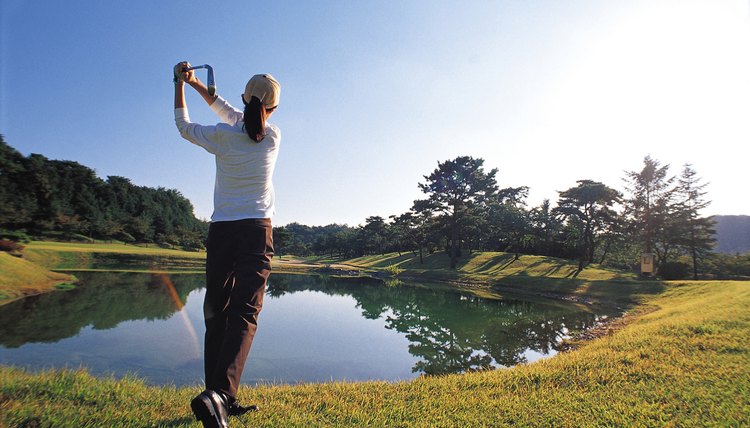The Phases of Movement for a Golf Swing

One of the great challenges of golf is playing at a consistent level. Learning how to build a consistent swing can help you to improve and enjoy the game every time you go out to play 18 holes. While you try to mesh the different parts of your swing together so that they function cohesively, there are four phases of movement with your swing.
Takeoff
This is the starting point for your shot. After you have set your position at address, you must start your swing. This is not easy because the laws of inertia apply to the golf swing. A body at motion tends to stay in motion; a body at rest tends to stay at rest. As a result, you need a trigger mechanism to get started. Many golfers use a small movement called a "waggle" to get their swing going. This is usually a small wiggle of the club head. Others trigger their swing with negative movement. Instead of taking the club back, you move your hands forward just a few degrees and then take your club back.
Upswing
Some golfers refer this as the backswing. During the upswing, you roll your hips to the rear and then allow your shoulders and arms to follow. Roll your hips as far back as they can comfortably go, and bring your arms back until your hands are at shoulder height. Your forearms and the shaft of your club should resemble the letter "L" when you are at the top of your upswing.
Downswing
This is the single most important phase of the golf swing because this is where contact with the ball occurs. Once again, the key to this phase is your hip movement. You should bring your hips through the ball and allow your hands to follow. The key to being successful in the downswing is to keep the speed of the swing consistent. Many golfers tend to slow down in this area because they fear making mistakes. Famed golf instructor Hank Haney thinks most amateur golfers believe they will have more control when they slow their swing. "I see amateurs who swing at a speed that's not even close to what they're capable of," Haney told Golf Digest. "Amateurs have this idea that if you make a smooth swing, somehow the ball just rockets off the club. It doesn't happen like that."
Follow-through
Golfers can be quite anxious after finishing the downswing and making contact. They want to see the results of the shot immediately. As a result, many golfers will pick up their heads so they can see the result of their swing. Instead of finishing with the club at shoulder height, they stop shortly after contact. A good golf swing will culminate with a strong follow-through that ends with the club at shoulder height.
Explore In Depth
References
- Golf Digest: The Big 4, Part 2
- Golf Tips: Power Fundamentals
- Leslie E. Smith et al. Acute and Chronic Health Benefits of TRX® Suspension Training®. American Council on Exercise sponsored study. 2016
- Mayo Clinic Staff. Golf Stretches. The Mayo Clinic. 2018
- TRX Training. TRX For Golf: TRX Golf Swing (Opposite Hands). 2016
Writer Bio
Steve Silverman is an award-winning writer, covering sports since 1980. Silverman authored The Minnesota Vikings: The Good, The Bad and The Ugly and Who's Better, Who's Best in Football -- The Top 60 Players of All-Time, among others, and placed in the Pro Football Writers of America awards three times. Silverman holds a Master of Science in journalism from the Medill School of Journalism.
